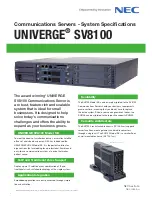
ASTi Telestra Target Operations & Maintenance Manual (Ver. 2, Rev. M)
2
Copyright © 2020 Advanced Simulation Technology inc.
1.1. Theory of Operation
1
The Telestra (also called a Target) is an embedded server that processes audio and
communications (Number 1 in Figure 1, below). The Target runs the Red Hat
®
Enterprise
Linux
®
operating system as well as a suite of custom software applications written and
maintained by ASTi.
2
Audio is processed in remote units called ACE-RIUs, ACUs, or ACU2s. Headsets, PTTs,
speakers, or microphones are plugged into these devices. The audio is sent digitally over
ACENet (Number 2 in Figure 1, below) to and from the Target. Crown Amplifiers can also be
connected to the ACENet and process audio from the Target. The ACENet runs over ethernet, but
is different from a typical LAN between computers. ACENet should be isolated from any other
network, and each remote unit receives a name instead of an IP address. Reference the ASTi
ACENet Guide for more information.
3
The Target runs a custom Project that processes the audio and simulates radios, intercom
systems, or sounds such as airplane engines or the rotors of a helicopter. The custom
project is a software load that makes the Target customized to a particular application such as a
flight simulator. Often a host computer is responsible for sending commands to the project
(Number 3 in Figure 1, below). In most cases, UDP packets are sent back and forth between the
Target and the host. These commands can control how audio is routed, how radios behave, or how
the sound effects are processed.
4
The primary tool for maintenance and troubleshooting tasks is called
the
Remote
Management Service (RMS) (Number 4 in Figure 1, below).
The
RMS is a web server
that runs on the Target and can be accessed by any computer on the same network as the
Target. Simply point a web browser at the IP address of the Target to access
the
RMS. The
health system, ACENet statistics, and the custom project are all managed and accessed in
the
RMS.









































